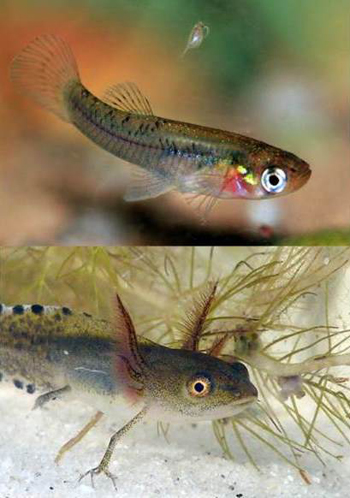Invasive fish have a high disruptive potential in aquatic ecosystems, in which amphibians may be highly impacted due to intense competition and/or predation on their eggs and larvae. Most studies have focused on the effect of large invasive fishes such as salmonids, whereas the effect of smaller fish on amphibians has been seldom investigated. The effects of the invasive Eastern mosquitofish (Gambusia holbrooki) on pygmy newts (Triturus pygmaeus), a species endemic to the Iberian Peninsula, were assessed. Outdoor mesocosms in Doñana National Park were set up with native aquatic flora and invertebrate fauna, and containing larval newts at two experimental densities. Density of larval newts was also crossed with presence or absence of mosquitofish, either free-swimming or caged, in order to distinguish consumptive and non-consumptive effects. Increased density of coexisting larval newts did not reduce their survival, but reduced their growth and development. Newt survival and size at metamorphosis were dramatically reduced in the presence of free-swimming mosquitofish, whether at low or high fish densities. Caged mosquitofish, however, had no effect on larval newts. In laboratory trials, mosquitofish preyed more efficiently on insect larvae than did larval pygmy newts, highlighting the high competitive potential of mosquitofish. This was confirmed by the depletion of zooplankton that free fish caused in the experimental outdoor mesocosms. This study suggests that invasive mosquitofish exert a high negative impact on coexisting newt populations. Such effects can be explained by a combination of direct predation, injuries caused by predation attempts, and intense competitive exploitation of common food resources. información[at]ebd.csic.es: Cabrera-Guzmán et al (2017) Competitive and predatory interactions between invasive mosquitofish and native larval newts. Biol Invasions DOI 10.1007/s10530-017-1369-5
http://link.springer.com/article/10.1007/s10530-017-1369-5

 Las altas temperaturas están provocando que las lagunas y las marismas de Doñana pierdan agua rápidamente
Las altas temperaturas están provocando que las lagunas y las marismas de Doñana pierdan agua rápidamente




